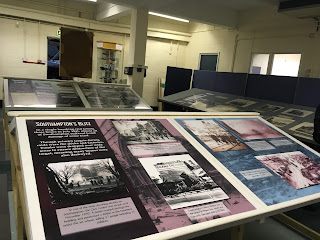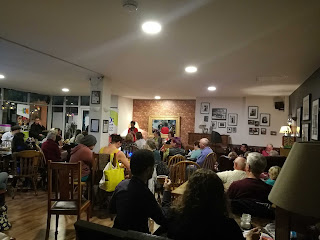An Interview with the Guardian of the ‘Mighty Beasts’.
On a grey day in November, I visited Solent Sky Museum in
Southampton. My mission was to interview the manager Steve
Alcock to hear his experiences about running a museum and to gather advice that
would be invaluable for anyone looking for clues on running their own museum or
exhibition.
 |
| Photograph of one of the mighty beasts |
Those of us who had arrived early had already enjoyed a
coffee and browsed the gift shop where there was a display of cards, postcards,
model cars and airplanes. While I sat at a café table under the aircraft
exhibits, I thought about the sights we would see on the tour. This, I
anticipated, would fill in the gaps in my knowledge of this museum’s stories,
and bring these huge metal beasts to life.
We were greeted by a pleasantly cheerful and relaxed Steve
Alcock, museum historian, for our tour of the Solent Sky Museum.Steve was a
natural storyteller and the ‘cheeky chappy’ talk was reminiscent of the
friendly banter I remember from Fords workers, or even my own grandfather, who liked
to tell a tale or two to us enthralled grandchildren.
 |
| Steve Alcock at reception - illustration by Jackie Eksi |
I wondered how many memories this place would induce in
veterans who witnessed the war first hand, or those who had scanned through the
grandparents’ faded sepia photos in dog-eared albums looking at planes,
uniforms and bombed out wreckages of Southampton.
The tour was informative, and entertaining. I was impressed
by the astronaut suit in the corner, and Steve’s name dropping of an astronaut
he’d met - the conversations he’d had with heroes that we had heard of, and those
we hadn’t.
The next place we were shown was the extensive book and
archives library at the back. While our team of researchers set about the pages
of information, I took the opportunity to find a quiet place to hold an
interview with Steve covering his job as historian and curator of the museum.
I had set out a series of questions the night before, just
for my own prompting. I wondered what skills does a social entrepreneur need to
run museum? How do you get people to visit a museum tucked away from the busy
public walk-ways of the city centre? How did this incredible museum get itself
noticed?
 |
| Interview in action - illustration by Jackie Eksi |
After the interview was concluded, I came to a few
conclusions of my own; that indeed being a confident and personable individual is
an advantage in the museum setting, so is a good knowledge of the subject of
the museum or exhibition you are invigilating. I
felt that being a good judge of body language is also useful. A closed body
language might mean visitors want to browse quietly or reminisce on something
personal. Not everyone wants their private thoughts interrupted. Others,
however, might feel neglected if no attempt is made to talk to them. So, I
think it’s important to observe and get a feel for the people’s mood when they
walk in. I suspect this gets easier over time.
My overall experience of the
museum was positive. The main hall was well laid out and roomy with well-lit
exhibits, clearly labelled titles and interesting information. I am a
very visual learner and I was keen to see how photographs were displayed and
labelled. I particularly liked that the background boards themselves were blown
up with large photographs of the same subject of the photos they contained.
Clever that. And the mix of objects and planes in one room with a side room for
photos made it easier in my case to take in smaller details without the bigger
displays distracting my eye.
 |
| One of the photographs on the story boards |
By Jackie Eksi, Transition project volunteer and artist
151
Albert Road South, Southampton. SO14 3FR.
Open
7 days a week, 10am – 5pm. Last entry 4pm.
Solent sky is an aviation
museum housing sea planes, aircraft, helicopters, aeronautical memorabilia and
a NASA astronaut suit. It tells the story of Southampton during WWII, including
the fatal bombings of Woolston Supermarine and Cunliffe Owen where Spitfires
and Seafires were made.




Comments
Post a Comment